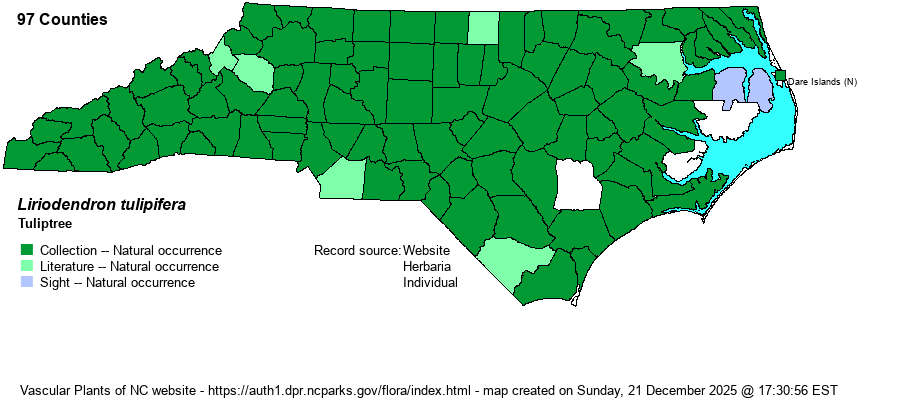| Author | L. | |
| Distribution | Throughout the state, but of spotty occurrence in the far eastern counties, with no known records for a few of them, though likely present in all 100 counties.
This is a classic Eastern species, ranging from VT, Ontario, and IA, south to central FL and LA.
| |
| Abundance | Common to abundant in nearly all areas of the state, easily found daily during field work in most parts of NC. However, in the far eastern counties it is rare to locally uncommon, even though some of the state's largest trees are at Pettigrew State Park in Tyrrell and Washington counties. Many of the famously large trees at Joyce Kilmer NF are Tuliptrees. | |
| Habitat | This is a classic species of Mesic Mixed Hardwood Forest natural community, but also of Rich Cove Forests and many other communities. It favors rich soils of forested slopes, but also can be common in rich bottomlands, mesic hardwood forests on gentle or flat slopes, and even in clearings in rich soils, where it can be a successional species. Surprisingly, it is found in acidic soils in the Sandhills and some other parts of the Coastal Plain, such as in streamhead swamps and pocosins, where it may grow with Pond Pine (Pinus serotina) and Atlantic White Cedar (Chamaecyparis thyoides). However, its normal tree associates are American Beech (Fagus grandifolia), Northern Red Oak (Quercus rubra), Florida Maple (Acer floridanum), and other broadleaf species. |
| Phenology | Flowers from April to June; fruits in September and October. | |
| Identification | This is a very familiar tree that is the largest tree in NC, on average. Many trees reach 100 feet tall, and a few reach 120 tall or taller. Identification is obvious in the growing season, with its unique deciduous leaves with mostly four lobes, having a rather truncate apex with a shallow V-notch; its large and also unique flowers (pale greenish-yellow petals marked with orange); its brown and papery cup-shaped fruit with many “seeds”; and its rounded “duckbill” terminal buds. | |
| Taxonomic Comments | This is the only member of the genus in North America. Weakley (2020) presents evidence that the form found in Sandhills and Coastal Plain habitats (NC to FL and LA) is an undescribed variety, with differently shaped leaves (smaller and blunter lobes) and a few other different characters. As mentioned above, the Coastal Plain taxon favors perennially moist, acidic soils, and will tolerate infrequent fire. BioDiv editors will await published data before splitting our text and map.
| |
| Other Common Name(s) | Yellow-poplar is just as often used for this species. Various combinations of the four words – tulip, yellow, poplar, and tree – are used, as well – such as Tulip-poplar. Of course, various combinations of spaces and hyphens are also used, such as Tulip Tree, Yellow Poplar, etc. Whitewood is a very rarely used name. As the species is not closely related to poplars (mainly in the genus Populus in the Family Salicaceae), it is best not to use that name. Of course, it is not related to tulips, either, but use of a single un-hyphenated word – Tuliptree – is idiosyncratic, which is appropriate for a tree that is the only representative of its genus in North America. | |
| State Rank | S5 | |
| Global Rank | G5 | |
| State Status | | |
| US Status | | |
| USACE-agcp | FACU link |
| USACE-emp | FACU link |

